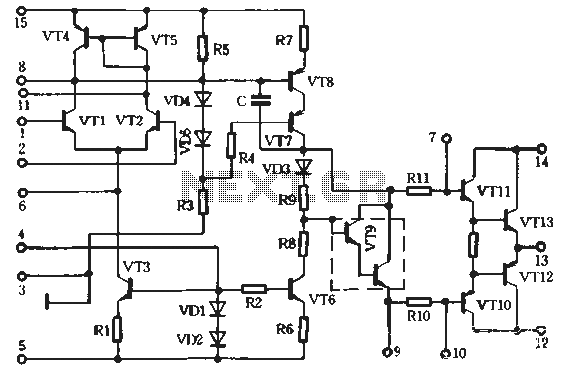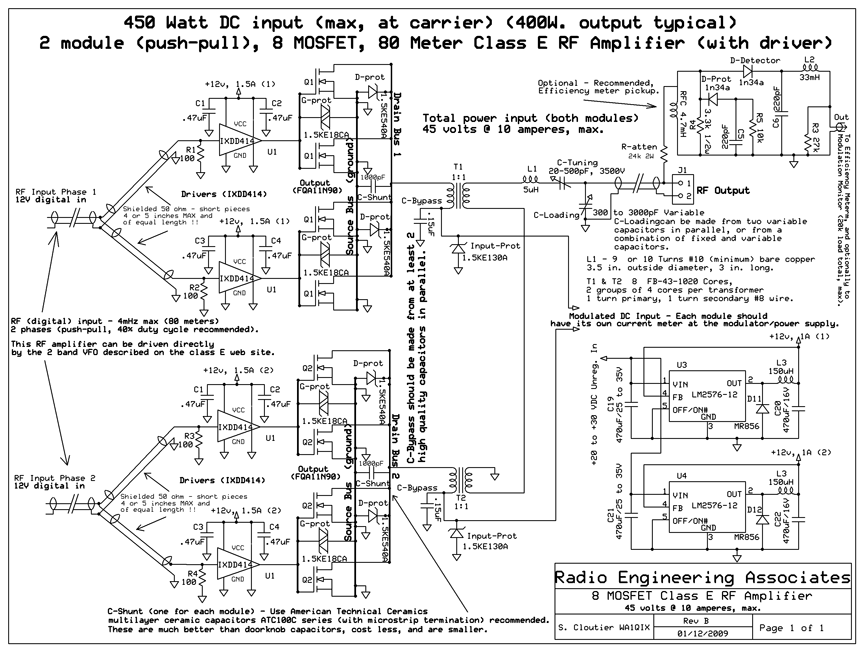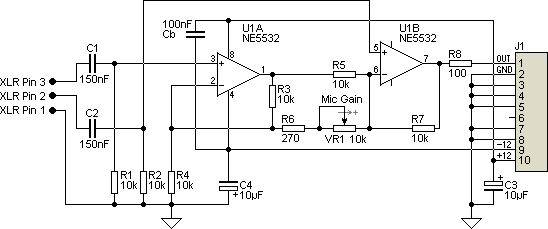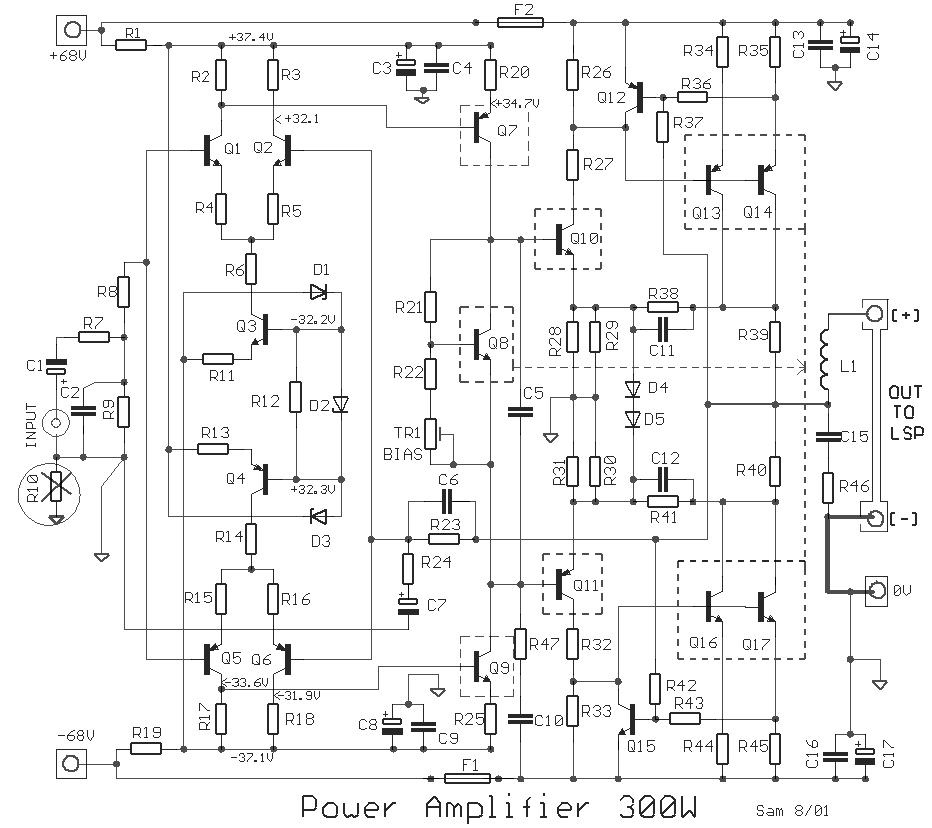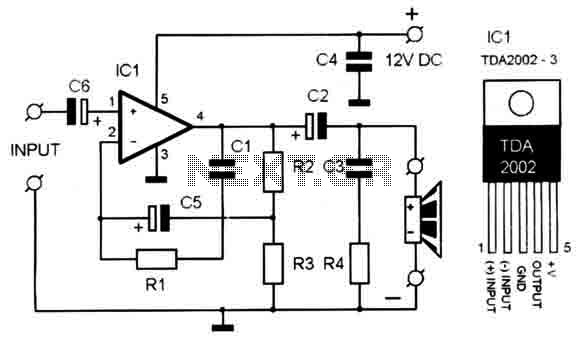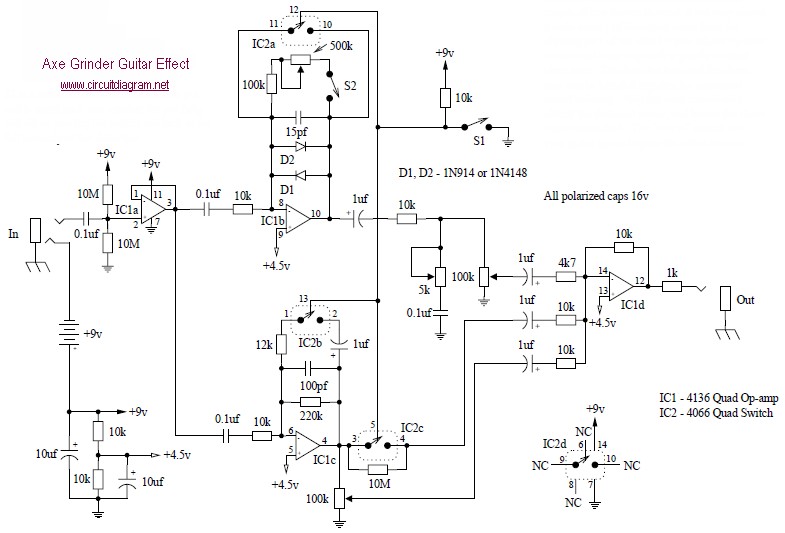
60 watt guitar amplifier

This design utilizes a well-established circuit topology for the power amplifier, employing a single-rail supply of approximately 60V and capacitor coupling for the speaker(s). The benefits for a guitar amplifier include simple circuitry, even with relatively high power outputs, and a certain degree of loudspeaker protection provided by capacitor C8, which prevents the voltage supply from reaching the loudspeakers in the event of output transistor failure. The preamplifier is powered by the same 60V rails as the power amplifier, allowing for the implementation of a two-transistor gain block capable of delivering around 20V RMS output, which results in a high input overload capability. The listed Darlington transistor types may be oversized for this design; alternatives such as MJ11014 (Q3) and MJ11013 (Q4) or TIP142 (Q3) and TIP147 (Q4) can be used. Diodes D1 and D2 can be any Schottky-barrier diode types. For a softer harmonic modifier operation, common 1N4148 silicon diodes can be used instead. It is crucial that the sensing transistor (Q2) is in close thermal contact with the output transistors when using Darlington transistors as output devices. Therefore, a TO126-case transistor type is selected for easy mounting on the heatsink, positioned close to the output pair. Resistor R9 must be adjusted to measure approximately half the voltage supply across the positive lead of capacitor C7 and ground. A more precise setting can be achieved using an oscilloscope to obtain symmetrical clipping of the output waveform at maximum output power.
This power amplifier circuit is designed for high-performance audio applications, particularly in guitar amplifiers, where sound quality and reliability are paramount. The use of a single-rail 60V supply simplifies the design and reduces the number of components, making it cost-effective and efficient. The capacitor coupling to the loudspeakers not only provides a high-pass filter effect but also protects the speakers from DC voltage, which can cause damage in case of a fault in the output stage.
The two-transistor gain block configuration enhances the amplifier's ability to handle high input signals without distortion, making it suitable for loud playing environments. The choice of transistors is critical; using MJ11014 and MJ11013 or TIP142 and TIP147 ensures that the amplifier can handle the power requirements without overheating or failing under load.
The selection of diodes D1 and D2 plays a significant role in the harmonic distortion characteristics of the amplifier. Schottky diodes offer fast switching and lower forward voltage drop, which can enhance performance, while the 1N4148 diodes provide a softer clipping characteristic, allowing for a more musical distortion when the amplifier is pushed to its limits.
Thermal management is a vital aspect of this design. The close thermal coupling of the sensing transistor (Q2) to the output transistors allows for accurate temperature compensation, ensuring that the amplifier operates reliably under varying load conditions. The use of a TO126 package for Q2 facilitates effective heat dissipation and simplifies assembly.
Finally, the adjustment of resistor R9 is crucial for achieving optimal performance. By measuring the voltage across capacitor C7, the designer can ensure that the output stage operates within its ideal parameters, preventing clipping and distortion at high output levels. Utilizing an oscilloscope for fine-tuning provides a visual representation of the waveform, allowing for precise adjustments to achieve the desired sound quality. This comprehensive design approach ensures that the amplifier meets the demands of both professional musicians and audio enthusiasts.This design adopts a well established circuit topology for the power amplifier, using a single-rail supply of about 60V and capacitor-coupling for the speaker(s). The advantages for a guitar amplifier are the very simple circuitry, even for comparatively high power outputs, and a certain built-in degree of loudspeaker protection, due to capacitor
C8, preventing the voltage supply to be conveyed into loudspeakers in case of output transistors` failure. The preamp is powered by the same 60V rails as the power amplifier, allowing to implement a two-transistors gain-block capable of delivering about 20V RMS output.
This provides a very high input overload capability. The Darlington transistor types listed could be too oversized for such a design. You can substitute them with MJ11014 (Q3) and MJ11013 (Q4) or TIP142 (Q3) and TIP147 (Q4). D1 and D2 can be any Schottky-barrier diode types. With these devices, the harmonic modifier operation will be hard. Using for D1 and D2 two common 1N4148 silicon diodes, the harmonic modifier operation will be softer. In all cases where Darlington transistors are used as the output devices it is essential that the sensing transistor (Q2) should be in as close thermal contact with the output transistors as possible.
Therefore a TO126-case transistor type was chosen for easy bolting on the heatsink, very close to the output pair. R9 must be trimmed in order to measure about half the voltage supply across the positive lead of C7 and ground.
A better setting can be done using an oscilloscope, in order to obtain a symmetrical clipping of the output wave form at maximum output power. 🔗 External reference
This power amplifier circuit is designed for high-performance audio applications, particularly in guitar amplifiers, where sound quality and reliability are paramount. The use of a single-rail 60V supply simplifies the design and reduces the number of components, making it cost-effective and efficient. The capacitor coupling to the loudspeakers not only provides a high-pass filter effect but also protects the speakers from DC voltage, which can cause damage in case of a fault in the output stage.
The two-transistor gain block configuration enhances the amplifier's ability to handle high input signals without distortion, making it suitable for loud playing environments. The choice of transistors is critical; using MJ11014 and MJ11013 or TIP142 and TIP147 ensures that the amplifier can handle the power requirements without overheating or failing under load.
The selection of diodes D1 and D2 plays a significant role in the harmonic distortion characteristics of the amplifier. Schottky diodes offer fast switching and lower forward voltage drop, which can enhance performance, while the 1N4148 diodes provide a softer clipping characteristic, allowing for a more musical distortion when the amplifier is pushed to its limits.
Thermal management is a vital aspect of this design. The close thermal coupling of the sensing transistor (Q2) to the output transistors allows for accurate temperature compensation, ensuring that the amplifier operates reliably under varying load conditions. The use of a TO126 package for Q2 facilitates effective heat dissipation and simplifies assembly.
Finally, the adjustment of resistor R9 is crucial for achieving optimal performance. By measuring the voltage across capacitor C7, the designer can ensure that the output stage operates within its ideal parameters, preventing clipping and distortion at high output levels. Utilizing an oscilloscope for fine-tuning provides a visual representation of the waveform, allowing for precise adjustments to achieve the desired sound quality. This comprehensive design approach ensures that the amplifier meets the demands of both professional musicians and audio enthusiasts.This design adopts a well established circuit topology for the power amplifier, using a single-rail supply of about 60V and capacitor-coupling for the speaker(s). The advantages for a guitar amplifier are the very simple circuitry, even for comparatively high power outputs, and a certain built-in degree of loudspeaker protection, due to capacitor
C8, preventing the voltage supply to be conveyed into loudspeakers in case of output transistors` failure. The preamp is powered by the same 60V rails as the power amplifier, allowing to implement a two-transistors gain-block capable of delivering about 20V RMS output.
This provides a very high input overload capability. The Darlington transistor types listed could be too oversized for such a design. You can substitute them with MJ11014 (Q3) and MJ11013 (Q4) or TIP142 (Q3) and TIP147 (Q4). D1 and D2 can be any Schottky-barrier diode types. With these devices, the harmonic modifier operation will be hard. Using for D1 and D2 two common 1N4148 silicon diodes, the harmonic modifier operation will be softer. In all cases where Darlington transistors are used as the output devices it is essential that the sensing transistor (Q2) should be in as close thermal contact with the output transistors as possible.
Therefore a TO126-case transistor type was chosen for easy bolting on the heatsink, very close to the output pair. R9 must be trimmed in order to measure about half the voltage supply across the positive lead of C7 and ground.
A better setting can be done using an oscilloscope, in order to obtain a symmetrical clipping of the output wave form at maximum output power. 🔗 External reference
